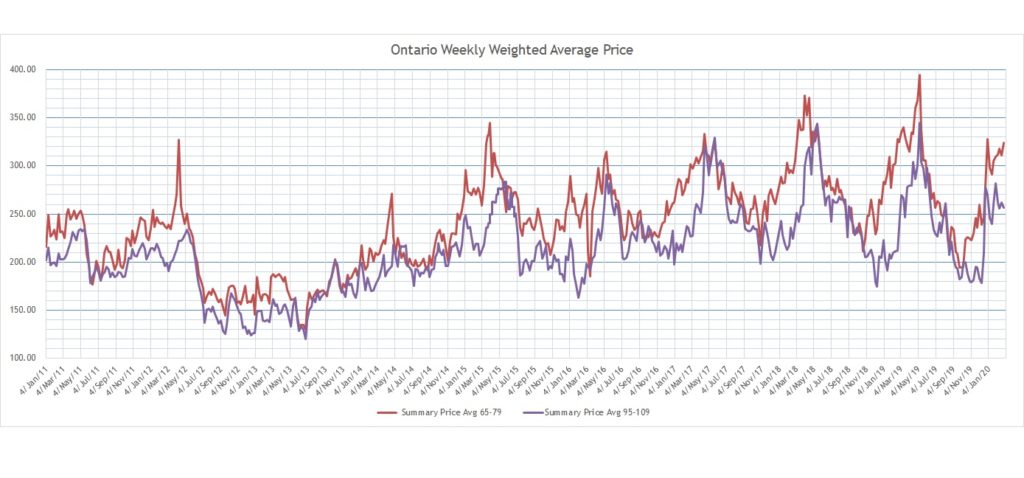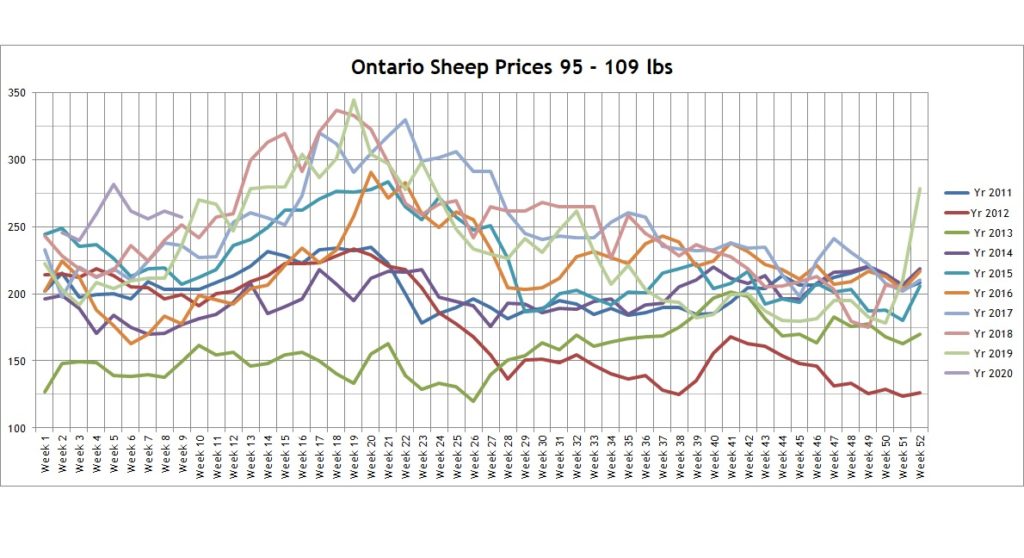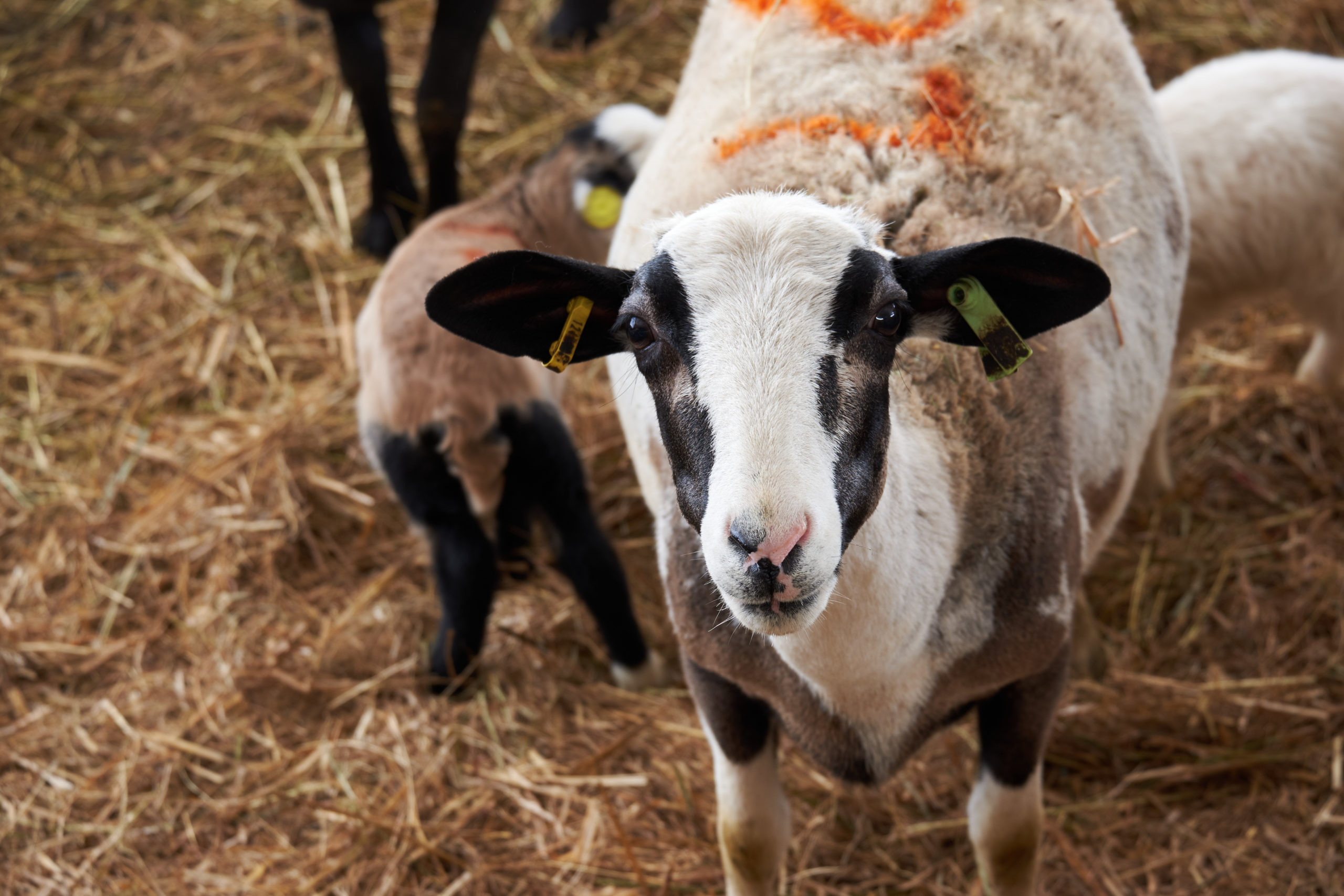When marketing sheep in Canada, farmers have three major routes; live auction, contract with an abattoir or direct marketing to consumers. The most common route is through a public live auction. The sheep are sold by the pound for what they weigh when they arrive at the sales barn.
Sheep prices are seasonal and cyclical. This means the highs and lows have some predictability to them. I’ve put together a bunch of data provided by the Ontario Sheep Farmers. The data set spans from 2011 to the end of February 2020. All of the prices are in dollars per hundredweight. To convert this to dollars per pound, divide by 100. For example, a price of $239cwt converts $2.39 per pound.
The major challenge for most sheep farmers is deciding when to market. I’m going to go over the factors you need to consider when working out your financial plans. The chart below shows the two main prices of lambs for the last 9 years.
Lights = Light lambs selling at a weight of 65 to 79 pounds (red)
Heavies = heavy lambs selling at a weight of 95 to 110 pounds (purple)

Sell all year
For a lot of producers, selling lambs all year is a goal. In this strategy, the focus is on production and volume, not about price. The hope is that you reach the average price over the course of the year and stabilize your cash flow. In theory, this works but the volume of lambs needed to make this a reality can be difficult to achieve. Sales barns sell the lambs in groups. Groups of less than 5 lambs typically have higher commissions, meaning you’d want to send larger groups to use the power of the average to your advantage.
Light lambs (65-79) have had the following average pricing (cwt):
- 2016 average was $251.68
- 2017 average was $277.81
- 2018 average was $281.89
- 2019 average was $274.56
- The 9-year average is $239.45
- The 5-year average is $269.35
Heavy lambs (95-109) have had the following average pricing (cwt):
- 2016 average was $220.54
- 2017 average was $248.70
- 2018 average was $249.56
- 2019 average was $232.80
- The 9-year average is $212.22
- The 5-year average is $235.20
The averages have been trending up but the seasonal trends are still there and have become even more marked in the last two years. If you are making budgets or financial plans, it is better to be cautious and keep the averages in mind. If you can not sell lambs on a weekly or bi-weekly basis, it might be tough for you to achieve the average lamb price.

Watching the spread
One piece of data that is very interesting to follow is the spread between the lights and the heavies. The spread is growing, in 2019 the price was $41.76 (cwt) lower on average for heavies compared to the lights. The 5-year average difference is $34.15 and the 9-year average spread is $27.23.
In the summer, the spread comes close to or actually inverts where the per pound price is higher for the heavies than the lights. By Christmas, it flips again and increases rapidly. From November to March, the spread increases up to $62 (cwt) on average.
Producers who have the genetics and ability to raise and sell both lights and heavies can definitely use the spread to their advantage, selling lights in the spring and heavies in the late summer. This does require knowing your cost of production on an ongoing basis. The spread should be the cost to add the additional weight on the lambs but when it inverts, it is potentially better to be selling heavies.
A Moving Target
The major demand base for lamb is the ethnic groups who want lambs for their various religious festivities. Ontario Goat produces a 5-year planner for the dates of the holidays and Ontario Sheep Farmers has a market demand outline updated annually.
These markets move every year because the religions rely on Hijri (Islamic) Calendar which is a lunar-based calendar. The major market is Easter which also moves every year. The price spikes that happen around these major holidays are a result of significantly higher demand and typically lower production.
Sheep typically breed best in the fall and lamb in the spring. With the major market demand in the early spring, it can be difficult to get the lambs to the desired market weight in the short time frame. Add in the moving target of the holidays and breeding can be a logistical challenge. In 2019, the price per pound difference between shipping in April and in October was $2.00 per pound. As much as having a steady supply of lambs all year would be great, the incentive to sell in the spring is very strong.
Other price factors
It is important to remember that each sales barn has its own price factors based on geographical location and the profile of the buyers that frequent that sales barn. Ontario Sheep Farmers does an excellent job of reporting the prices from all the major sales barns that participate. Some sales barns are always below the provincial average. There can also be a breed bias in some locations based on what the buyers in those areas want to buy. If you plan to market a specific type of sheep, it can be helpful to speak to other producers who already market that type of sheep.
There are transportation costs and commission costs to be considered. If the sales barn is located further away from the GTA, prices tend to reflect the transportation costs of moving those sheep closer to the major markets and abattoirs. Each sales barn sets its own commission fees. These can vary depending on how many lambs you sell at a given sale. If you have a choice between two sales barns, it can be worth the time and effort to find out their fee structure.
Pick your strategy
When you are trying to figure out the best marketing approach for yourself and you pick the auction market, I would focus on the following facts:
- Know which type of lamb your sheep produce the best. Some sheep breeds excel at producing heavy lambs and other excel at light lambs. Forcing a breed that trends towards light lambs into the heavy category will only drive up your costs.
- Figure out your production system and when your lambs will be ready. If you are focusing on a low-cost annual system with pasture lambing it might be a major challenge for you to produce lambs for the Easter market.
- Calculate your production volume as accurately and honestly as you can. You need to know how many lambs you will likely market in a given year. You can use the production planner here to guide you on matching your production system with your volume.
Once you know your market, set a base price for yourself based on the averages available. Then map it out over the price charts, highlighting which time periods you would be most likely to receive your base price or better. Compare this to your production system to see how the two compare.
If you have a lower production volume, you might find that taking extra steps to switch to fall lambing is better for you in the short term. If you pasture lamb and have been caught in the low fall prices in the last two years, you might adjust your feeding to hold onto those lambs for an extra 3-4 weeks to meet the historically better pricing in late November.
This chart here shows the heavy lamb price for each year. If you set your base price at $225 (cwt), you would find that the market offers that price most of the year with the exception of September and October most years.

Focus on what matters
When you pick a base price, you can move away from chasing the highest prices and focus on keeping your costs in line and maximizing your contribution margin per sheep over the whole year. It’s always nice to hit those Easter highs but if that’s only 10% of your production volume and the rest of your lambs are ready to sell in the first week of October, your cost of production needs to be on point. Just make sure your base price is realistic for the time period that the bulk of your lambs are market-ready.
Even though nobody has a crystal ball to predict the lamb price next week, after looking at all the data for the last 9 years I can tell you that there are predictable trends. As long as you keep your revenue expectations inline with these trends, selling your lambs through the sales barn can be an excellent marketing option. You can find the trends of other weight classes of sheep on the Ontario Sheep Farmers website.

[…] methods you want to use. There are multiple posts about raising sheep throughout the blog including Marketing Sheep through Auctions, and Purchasing […]